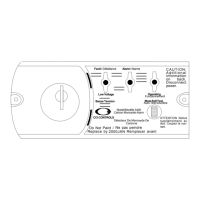REV B
4/13/04
INSTRUCTIONS
These instructions include information on the installation,
maintenance, and operation of the carbon monoxide (CO)
alarm that is installed in your residence. It is important to read,
to follow,and to keep these instructions in a handy location so
you can refer to them as necessary. A properly installed and
maintained CO alarm is an important part of your residential
safety plan. Therefore, you and your family should read and
follow this manual thoroughly.
In the event you have questions regarding the use of this CO
alarm,call (800) 521-5228, Monday through Friday, 8 a.m. to 5
p.m. Pacific Standard Time. View our other innovative products
on the web at www.ccicontrols.com.
When the alarm sounds on this device and the RED Alarm
indicator light flashes, they indicate the presence of carbon
monoxide (CO) which can be FATAL. The alarm will continue
to sound until the carbon monoxide has dissipated or until the
mute button is activated.
4) If your alarm reactivates within a 24 hour period,
repeat above steps and call a qualified appliance
technician.
CAUTION: This alarm will only indicate the pres-
ence of carbon monoxide (CO) gas at the sensor. CO
gas may be present in other areas of the residence.
What are the symptoms of carbon
monoxide poisoning?
CO is an odorless, colorless, invisible, tasteless and non-
irritating gas that is almost undetectable to your five senses. In
many cases of carbon monoxide poisoning, people report
feeling sick and too disoriented to exit the residence or to call
for assistance. Therefore, it is important to know the symp-
toms of exposure to CO that could result in poisoning.
Mild Exposure: Slight headache, nausea, vomiting, and/or
fatigue (often described as flu-like symptoms).
Medium Exposure: Severe throbbing headache, drowsiness,
disorientation, confusion and/or a fast heart rate.
Extreme Exposure: Unconciousness, convulsions, cardio-
respiratory failure, and death.
Many cases of reported CARBON MONOXIDE POISONING
indicate that while victims are aware they are not well, they
become so disoriented they are unable to save themselves by
either exiting the building or calling for assistance. Also, young
children and household pets may be the first affected.
If alarm sounds (4 beeps every 5 seconds):
1) Depress the mute button.
(telephone number)
3) Immediately move to fresh air outside, or by an
open door or window. Do a head count to check that
all persons are accounted for. Do not re-enter the
premises or move away from the open door or
window until the emergency service personnel
have arrived, the premises have been aired out,
and your alarm returns to its normal condition.
2) Call your emergency services .
[Fire Department or 911]
(telephone number)
Have the technician investigate for sources of CO
from fuel burning equipment and appliances, and
inspect for proper operation of this equipment. If
problems are identified during this inspection, have
the equipment and appliances serviced immedi-
ately. Note any combustion equipment or appliance
not inspected by the technician and consult the
manufacturer's instructions, or contact the manu-
facturers directly, for more information about CO
safety of this equipment. Make sure that motor
vehicle are not, and have and have not been, oper-
ating in an attached garage or adjacent to the resi-
dence.
The following are symptoms related to CARBON MONOXIDE
POISONING and should be discussed with ALL members of the
household:
OPERATING INSTRUCTIONS CARBON MONOXIDE GAS ALARM
MODEL 3400 for RESIDENTIAL USE
Actuation of your CO alarm indicates the presence of
carbon monoxide (CO) which can KILL YOU.
WARNING!
ATTENTION:
Your CO gas detector is operating at all times when it is
connected to its power source. This detector will only operate
when supplied with the stated operating voltage. This detector
is a safety device. It must not be connected in such a way as
to allow it to be switched off by the use of a wall switch or similar
device, or to become disconnected from its power supply due
to the use of a GFCI protected circuit.
Carbon Monoxide Symtoms.
Model 3400 Carbon Monoxide Gas Alarm
CAUTION: Additional information on back.
Auto-Test Sourdine
Alarm / Alarme
CAUTION:
Additional
information
on back.
Disconnect
power.
Fault / Défaillance
ATTENTION Notice
supplémentaire au
dos. Coupez le cou-
rant.
Operating
Functionnement
Mute Self Test
Replace by
Do Not Paint /
Remplacer avant
2000JAN
Ne pas peindre
Basse Tension
Low Voltage
CCI CONTROLS
Model/Modéle 3400
Carbon Monoxide Alarm
Détecteur De Monoxyde De
Carbone
23
234
234
234
234
234
!

